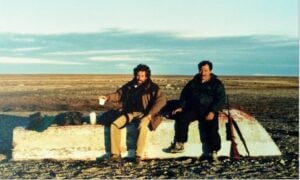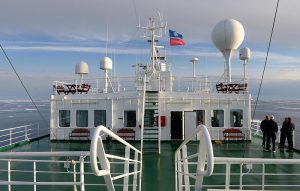
History
2014 Victoria Strait Expedition
This year's search is about much more than underwater archaeology. The Victoria Strait Expedition will contribute to northern science and communities.
- 1205 words
- 5 minutes
This article is over 5 years old and may contain outdated information.
History

“This is truly a historic moment for Canada. We have found one of the two Franklin ships,” says Prime Minister Stephen Harper in a small room in Parks Canada’s underwater archeology headquarters in Ottawa. “For more than a century this has been a great Canadian story and the subject of scientists, historians, writers and singers. I think we have a really important day in mapping together the history of our country.”
The ship was found in what appears to be good condition in the Queen Maud Gulf, south of the primary search area. A sonar “tow-fish” which scans the seafloor while being towed behind a ship captured the first images of the ship, which was found in about 11 metres of water on a relatively flat stretch of seafloor. Then a remotely operated vehicle equipped with a camera was deployed to capture the first detailed images and videos of the wreck. It isn’t yet known if the ship is HMS Erebus or Terror, but Ryan Harris, a senior underwater archaeologist with Parks Canada, says some features on the deck of the ship are still intact, which hopefully means the interior is also in similar condition.
The original plan for this summer’s search had been to scour the Victoria Strait, but challenging ice and weather conditions forced the hunt south. “The ice was unusually thick this year, says Jody Thomas, deputy commissioner of the Canadian Coast Guard. “We weren’t able to get into the search site because of the ice.” But what at first seemed like a setback turned into what Thomas describes as “serendipity,” as the ice forced the search south of Victoria Strait into Queen Maud Gulf, where archeologists found some artifacts on an island that helped further narrow the search area. Within days the discovery of the ship was made.

This was Parks Canada’s sixth consecutive year searching for the ships, which were lost during Sir John Franklin’s 1845-1848 expedition searching for the Northwest Passage. It’s also the biggest search they’ve ever mounted thanks in part to a team assembled by The Royal Canadian Geographical Society that included The W. Garfield Weston Foundation, the Arctic Research Foundation, One Ocean Expeditions and Shell Canada. John Geiger, CEO of RCGS, describes the team as “a formidable group of private and non-profit partners.” The group joined the Royal Canadian Navy, the Canadian Coast Guard and Parks Canada to form a public-private partnership with four vessels — the Royal Canadian Navy’s HMCS Kingston, the Canadian Coast Guard ship Sir Wilfrid Laurier, the Arctic Research Foundation’s Martin Bergmann and One Ocean Expedition’s Voyager.
This year’s success doesn’t mean an end to the search, of course. “We’ve got half the story here,” says Geiger. “It’s a big break, but there’s a piece missing for sure.” For now the expedition will focus on the nearly 170-year-old wreck. Andrew Campbell, a vice-president at Parks Canada, says that after a little rest, the archeology team will be diving on the wreck to try to determine which of the two ships it is, and what it can tell them about the final days of the Franklin Expedition. Campbell says they’ll remain at the site as long as they can before retreating from the onset of winter ice.
Are you passionate about Canadian geography?
You can support Canadian Geographic in 3 ways:

History
This year's search is about much more than underwater archaeology. The Victoria Strait Expedition will contribute to northern science and communities.

History
Arctic historian Ken McGoogan takes an in-depth, contemporary perspective on the legacy of Sir John Franklin, offering a new explanation of the famous Northern mystery

History
First official day of the 2014 search for Sir John Franklin’s lost ships

People & Culture
On April 12, Franklin enthusiasts had a rare opportunity to come together in the same room as The Royal Canadian Geographical Society presented their 2016 Can Geo Talks